
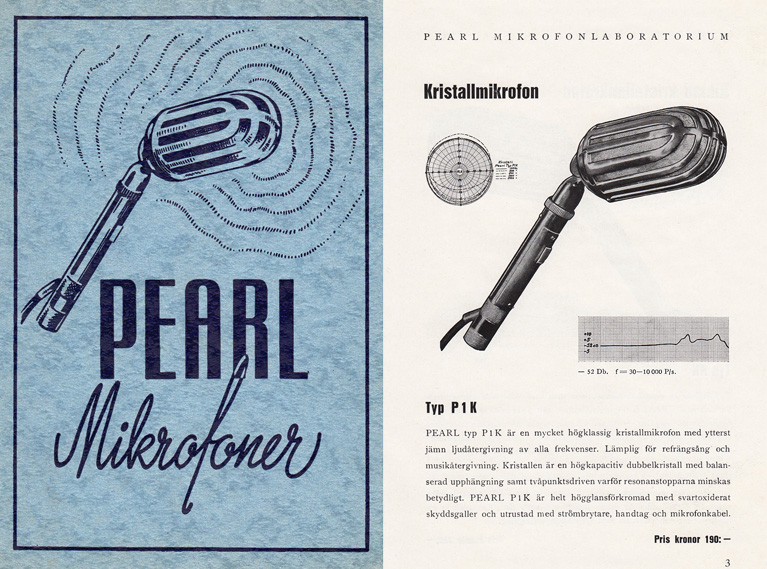
1910-1950: Born in Västerås, Sweden in 1914, Rune Rosander discovered an early interest in microphone technology and started experimenting with crystals in the 1930s while working for Swedish industrial giant ASEA (that later became ABB). In 1939, he founded Pearl Mikrofonlaboratorium (PML) in Stockholm, but the company was not formally incorporated until 1941. The isolation of World War II made it difficult to import components, so Mr. Rosander started growing Rochelle Salt crystals in his own home. The wartime lack of spare parts for imported microphones and a need for domestically produced microphones created a quickly growing market for Pearl.
The expanding post-war economy of the late 1940s brought new business opportunities with significant exports to the other Nordic countries and large sales to customers in new market segments, like Scandinavian Airlines (SAS), founded in 1946.
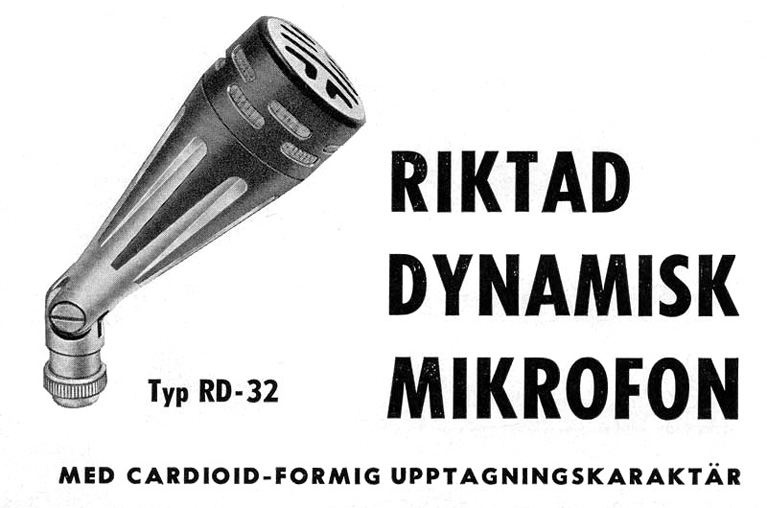
1950s: With a growing business – and confidence – Pearl ventured into new areas of microphone technology. In the 1950s, a whole new range of microphones were introduced, including both dynamic and condenser models such as the RD-32 (pictured). Mr. Rosander started experimenting with new capsule shapes and presented the rectangular capsule to the world in 1958. Several products built around the new capsule were introduced in 1959, for instance the 8-CK and the C-2 tube microphones.
In 1954, Rune Rosander hired 18-year-old precision mechanic Bernt Malmqvist, who quit his job at the post office workshop to join Pearl in Spånga. More new employees would follow, but when the decision was made to move the business to Scania, the southernmost region of Sweden, Bernt Malmqvist was the only employee who made the move with Mr. Rosander.
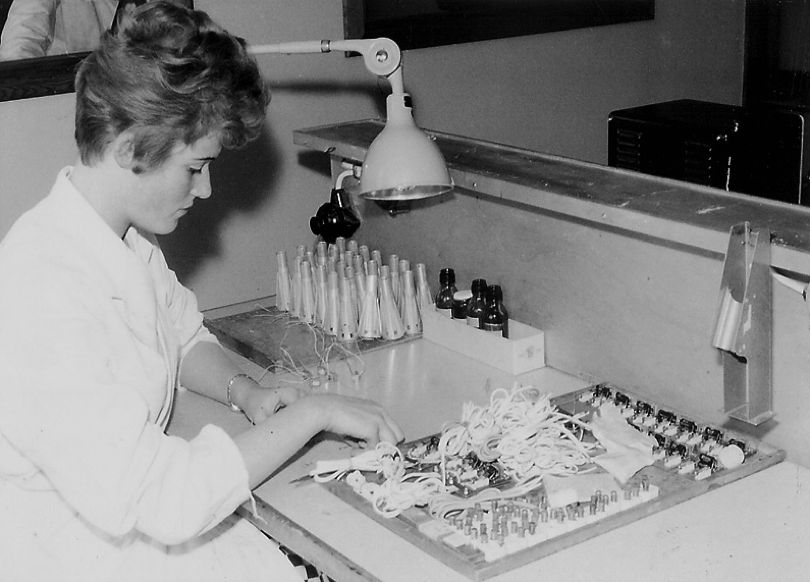
1960s: Mr. Rosander and Mr. Malmqvist settled down in a new industrial facility in Åstorp in 1960 and hired their first new employees, including Margareta Svensson and Gunnel Ågervall (pictured).
The bulk of the company’s revenue still came from the defence and industrial sectors, but the new condenser microphones had generated a growing market within the world of film and music production. This in turn created an incentive for the company to develop higher end microphones for their use. Towards the end of the decade, several solid-state condensers saw the light of day, such as the DC-96 and the TC-4. With these models, Pearl introduced a new style of design that is still present in modern products like the Milab DC-196.
The dimensions of the rectangular capsule made it possible to construct very compact large-diaphragm microphones, but the small size was not appreciated everywhere and Pearl introduced a larger export version of the TC-4 – the TC-4 US – built specifically for the US market.
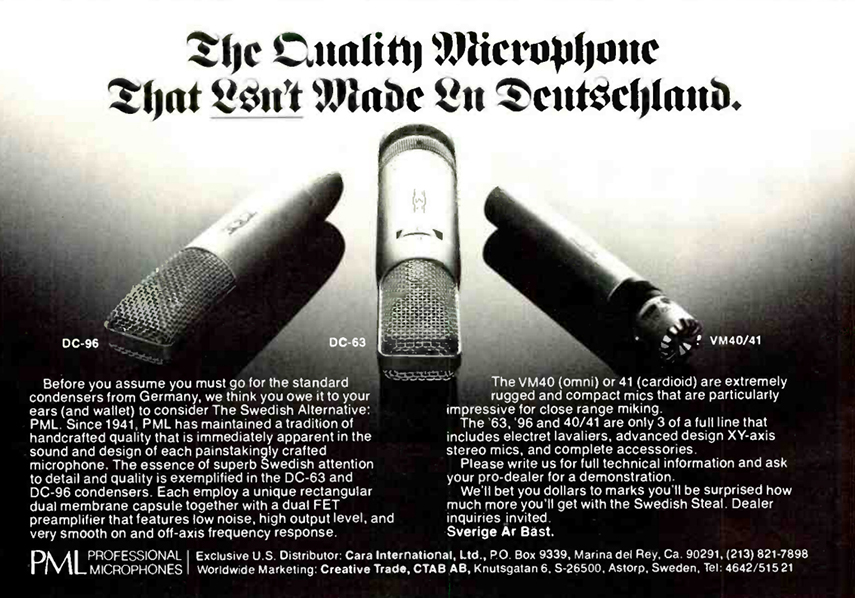
1970s: When the Swedish Parliament moved to Kulturhuset in 1971, the new chamber was fitted with PML microphones – DC-73’s for the speaker podium and DC-21’s for the individual desks.
In 1972, Pearl introduced the DC-63, a compact multi-pattern microphone based on the rectangular capsule which offered a staggering 44 different combinations of patterns, pads and filters. An updated version with more intuitive switches was presented in 1979 (pictured).
In 1978, the business development strategy led to the creation of a new company that would produce and market the microphones, while Pearl would step back from the spotlight and focus on R&D. This new setup was mostly a formality at first but would later lead to significant consequences.
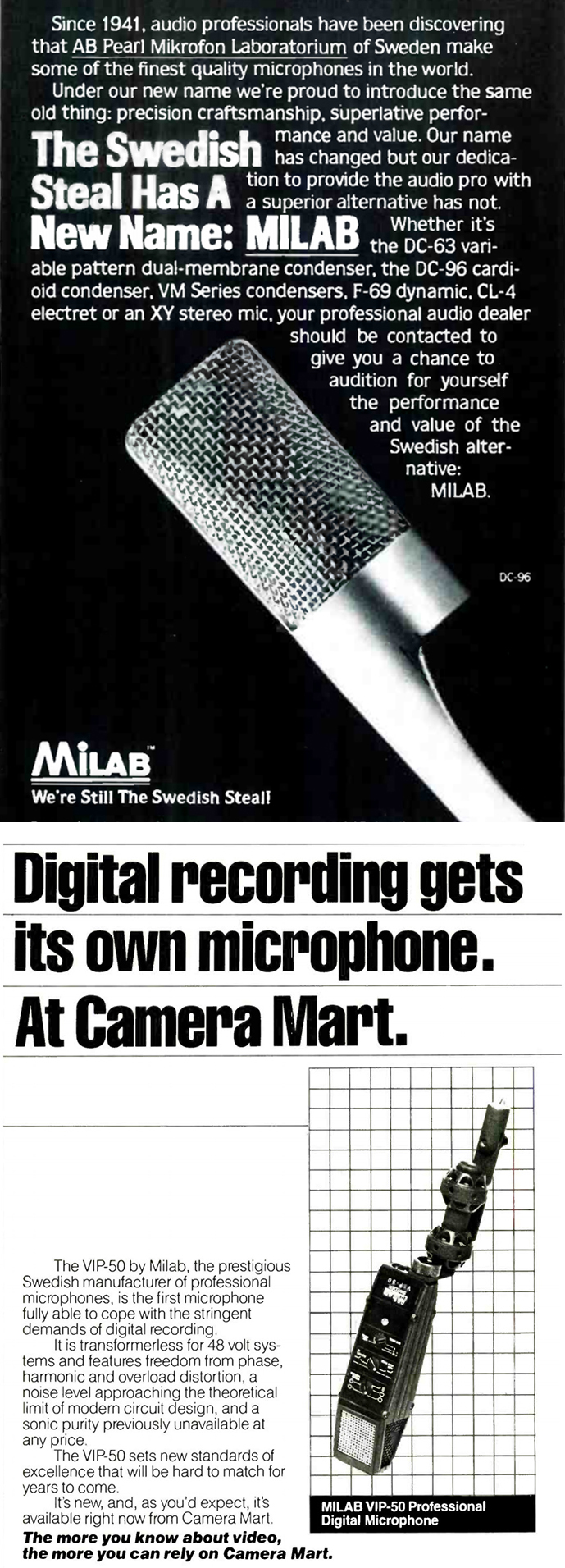
1980s: The new company, managed by Rune Rosander’s son and with Bernt Malmqvist as production manager, was initially named Creative Trade AB (CTAB), but from 1980 the products were rebranded with a new name – MILAB (abbreviated from Pearl MIkrofonLABoratorium). Most tools, employees and products were transferred to CTAB, which is why products from this period, such as the DC-63, DC-73 and VM-41, can be found with both PML and Milab logos.
Over time, father and son Rosander developed irreconcilable views on the future of the business and, eventually, the two companies went separate ways. CTAB became Milab International AB.
The first new Milab model to be developed after the companies had been separated was the LC-25 – a handheld condenser designed by Bernt Malmqvist. It was a huge success for Milab and paved the way for the LSR series of handheld condenser microphones.
In 1982, Margareta Svensson brought in her teenage son, Hans, as a summer temp. After graduation, he started working full-time and is still with Milab to this day, currently as production manager.
At this time, Rune Rosander was running Pearl as a one-man business and had given up the rights to his own products and capsule designs to Milab. In 1984, he introduced the first new model with the Pearl brand since the split from Milab – the dual-output TL 4, fitted with a new rectangular capsule – the Pearl 2800. An updated version of the TL 4 is still in production today, the Pearl TL 44.
That same year, Milab was acquired by the Bilsom Group and introduced one the most iconic models in the history of the company, the Milab VIP-50. The VIP-50 would become Milab’s claim to fame in the USA when it became a go-to mic for studio vocals by heavyweights like Quincy Jones, Bruce Swedien, Richard Perry and Terry Howard. Ray Charles reportedly called the Milab US distributor himself and ordered three VIP-50’s after a recording session where Bruce Swedien introduced him to the Swedish microphone. Michael Jackson even included a “special thanks” to Milab in the liner notes for his 1991 album Dangerous.
In 1986 Milab received the largest single order in the history of the company when almost 1000 microphones (a custom model called CM-22) were built for the Australian Parliament House in Canberra which was opened by Queen Elizabeth II on 9 May 1988.
This was an exciting time for Milab, but Bernt Malmqvist had grown tired of his role as production manager since it involved very little hands-on time with the microphones. When an ageing Rune Rosander offered to sell his beloved company, Bernt Malmqvist seized the moment. In 1987, he resigned from Milab and took over Pearl together with his wife Margita. Since there were only two models in the Pearl range – the TL 4 and a new M-S stereo microphone called the MS-8 – substantial effort was put into devoloping new products. Before the end of the decade, Pearl had launched several new models, including the CC 30, the predecessor to the current CC 22.
Around the same time, Milab found a new R&D manager in Per Ove Almeflo who would design a number of significant models over the next 25 years, including the Milab VM-44 which was released in 1988 and boasted a brand new small diaphragm condenser capsule.
In 1989, Rune Rosander was honoured with the AES Fellowship Award for his contributions to the world of audio engineering.
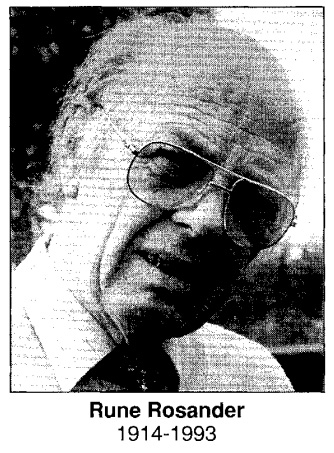
1990s: In 1990 Bernt & Margita Malmqvist purchased a new property on Vallbogatan in Åstorp which would be the home of Pearl (and later Milab) for the next 34 years.
Milab Microphones was acquired by TN Development on January 1, 1993, and all production was moved to Helsingborg except for the anechoic lab that remained in Billesholm where the company had been based during the Bilsom Group years.
Later that year, on April 5, Rune Rosander, the founder of PML, passed away after devoting well over 50 years of his life to microphones.
During the second half of the 1990s, Milab teamed up with Lund University to develop a digital microphone. In 1999, the collaboration resulted in the Milab DM-1001, the world’s first commercially available digital microphone. Many misconceptions about digital microphones were proven wrong with the warm natural sound of the DM-1001 and Resolution Magazine called it “a digital microphone with a soul“.
Another noteworthy release from the late 1990s is the Pearl CC 22 which is still the best-selling Pearl model today.
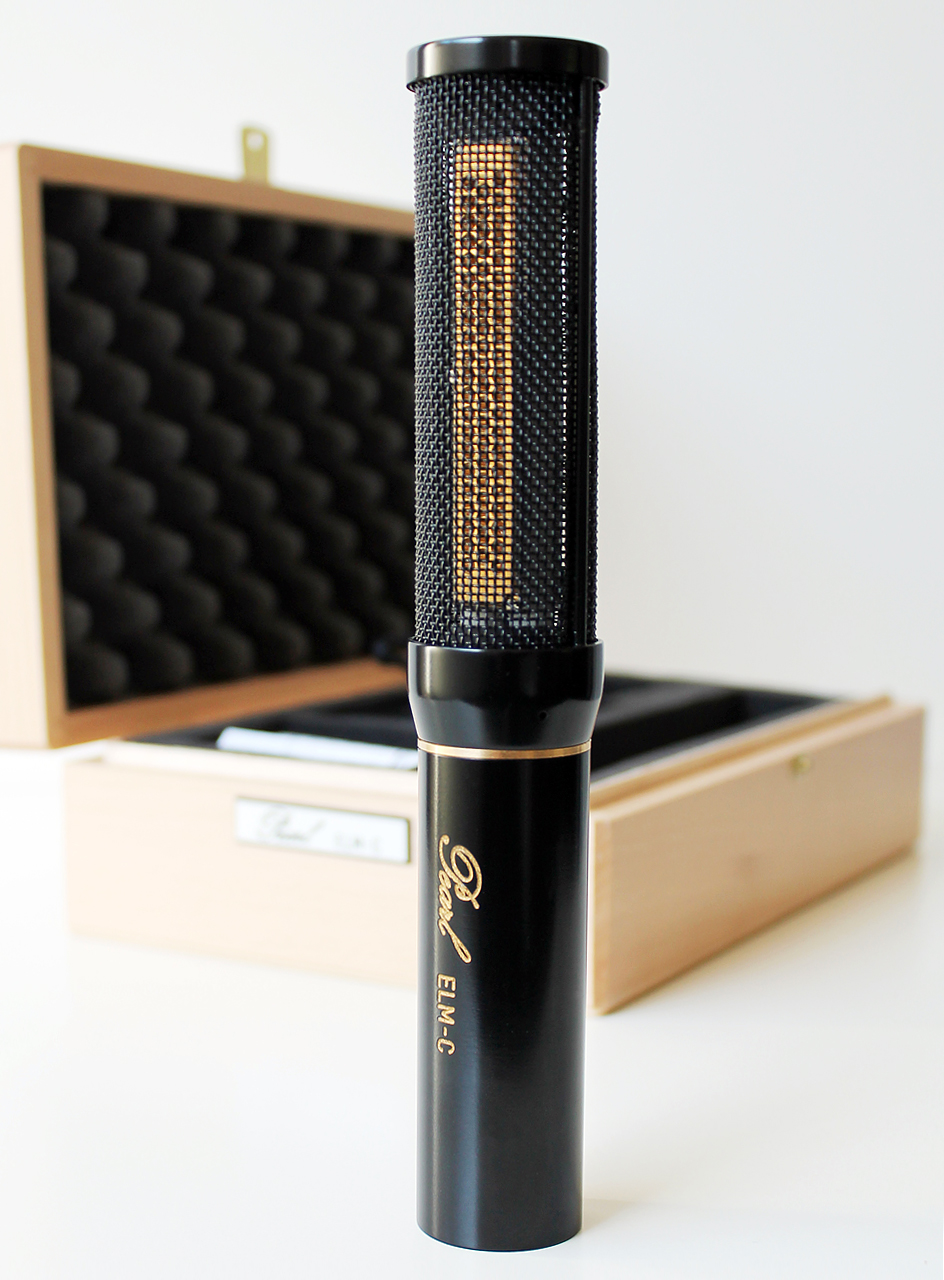
2000s: After discussions with Grammy-winning engineer Kavi Alexander, Bernt Malmqvist started experimenting with a more extreme shape of the rectangular capsule based on a 7:1 length/width ratio, instead of the 2:1 ratio of the “regular” rectangular capsule. The idea was that a longer membrane would exhibit a much narrower vertical than horizontal polar pattern, a property that would provide a skilled engineer with a new tool to handle difficult acoustical environments, for instance by minimizing unwanted reflections from the floor and ceiling.
In 2003, Kavi Alexander used the first prototypes with extended capsules to record the Saint Petersburg Philharmonia for Water Lily Acoustics. A couple of years later there were three commercially available models, the cardioid ELM-C (pictured), the bidirectional ELM-B and the dual-output ELM-A. The unique characteristics of the ELM capsule quickly caught the attention of classical music engineers and the very first units were sold to Swedish Radio P2 (classical and jazz) and the Royal Swedish Opera in Stockholm.
At Milab in Helsingborg, R&D manager Per Ove Almeflo had been busy improving the rectangular capsule and in 2006 Milab presented the multi-pattern DC-196 with the new Milab 2900 capsule. Mr. Almeflo used three matched capsules of the same type to create a new innovative surround microphone, the SRND 360, which was named “Microphone of the year” in 2008 by German Soundcheck Magazine.
In 2009, Gunnel Ågervall, who had been one of the very first new employees when Pearl moved to Scania, retired after nearly 50 years of working for Pearl and Milab.
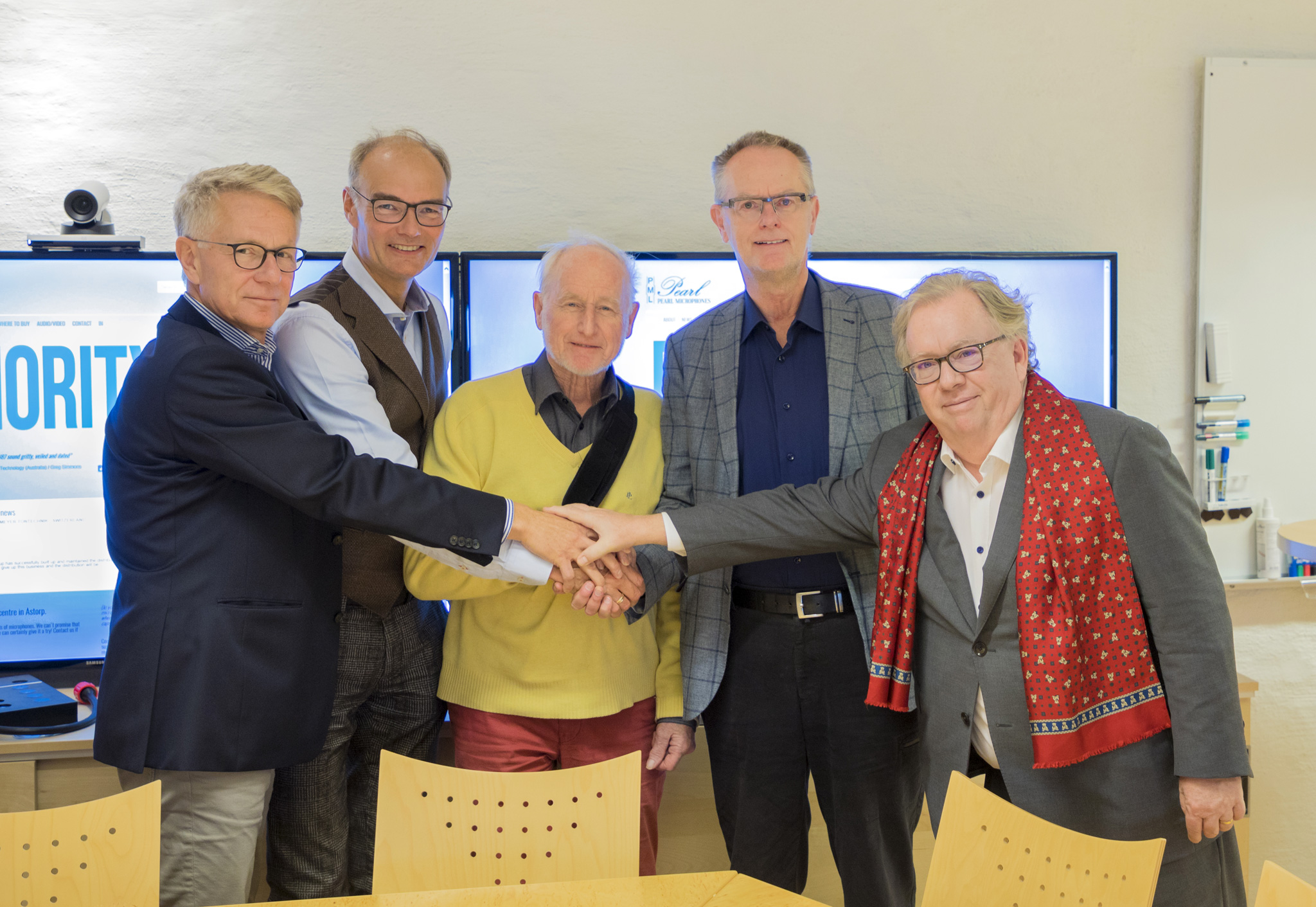
2010s: At the age of 81, Bernt Malmqvist had definitely earned the right to a retirement after 63 years in the microphone business and signalled that he was prepared to sell his company. On November 1, 2017, Milab Microphones acquired all the stocks in Pearl Microphones and the two former siblings were re-united after almost 40 years as separate companies. The picture shows the formal hand over with Bernt Malmqvist in the middle and the new owner, Thomas Nöjdh, second from the left.
Within a few months, Milab had moved its production unit from Helsingborg to Pearl’s facility in Åstorp and since then, the two brands have been manufactured under the same roof.
In 2018, Production Manager Hans Svensson brought in his son Esaias to the Milab/Pearl team, making him a third-generation microphone builder from the same family, a story that began with his grandmother Margareta in 1960.
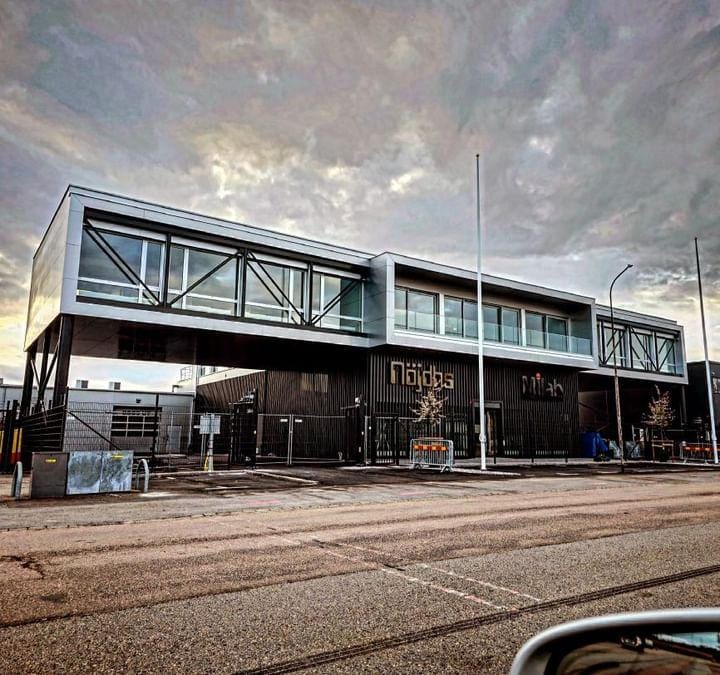
2020s: Two significant new products were introduced in the early 2020s:
The Milab VIP-60 saw the light of day in late 2021 and immediately received stellar reviews. It was dubbed “Gear of the Year 2022” by Sound on Sound Magazine and became the best-selling Milab model of 2022.
As a final project to crown his career before retirement, Bernt Malmqvist had been working on a signature tube microphone during the Covid pandemic. After extensive testing, the Pearl ELM-T Bernt Malmqvist Signature Edition tube condenser microphone was released in the summer of 2023.
A big milestone in the history of Milab and Pearl came in May 2024 with the move to a completely new building in Helsingborg, Sweden. The icing on the cake was the brand-new anechoic chamber, built by IAC Acoustics to the highest international standards.